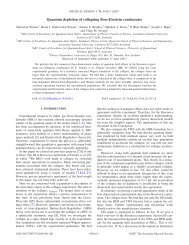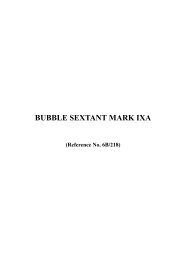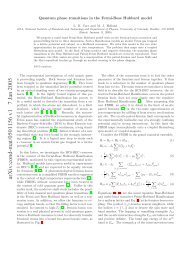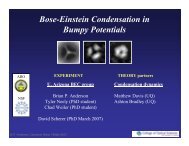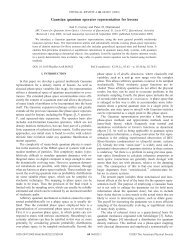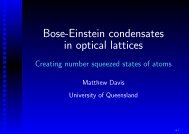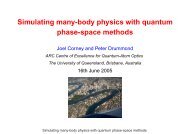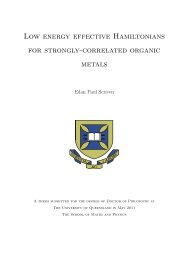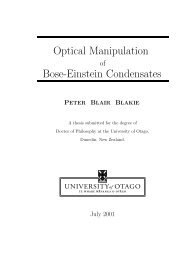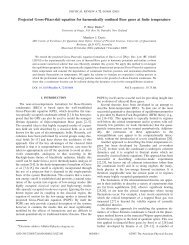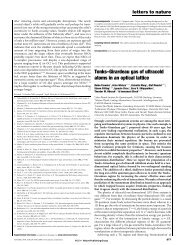Open Quantum Dynamics of Mesoscopic Bose-Einstein ... - Physics
Open Quantum Dynamics of Mesoscopic Bose-Einstein ... - Physics
Open Quantum Dynamics of Mesoscopic Bose-Einstein ... - Physics
You also want an ePaper? Increase the reach of your titles
YUMPU automatically turns print PDFs into web optimized ePapers that Google loves.
7. <strong>Quantum</strong> simulations <strong>of</strong> evaporatively cooled <strong>Bose</strong> condensatescurves is well accounted for by the statistical error that arises from using a finite number<strong>of</strong> trajectories in the ensemble averages.7.5.3 Angular momentum and vorticesFor the finite-size condensates in atom traps, just as the final ground state is not expectedto be precisely the zero momentum eigenstate, so too such condensates are not constrainedto fall into the L = 0 angular momentum eigenstate. Individual atoms in the initialdistribution have arbitrary angular momenta, as do escaping atoms. Central limit theoremarguments show that the variance in angular momentum will scale approximately as 〈ˆL 2 〉∝N. Thus we can expect that each trapped condensate should have angular momentum,unless constrained by the trap geometry. The angular momentum can be carried either byquasiparticles or vortices[108, 140]. A j-th order vortex has momentum L = jN/m andtherefore cannot form spontaneously in the thermodynamic limit <strong>of</strong> large N. However,recent work [5] has suggested that a vortex may form spontaneously when a condensate isquenched suddenly below the critical temperature. For small condensates, a spontaneousj = ±1 vortex may be quite likely, even without this rapid quench.Vortices may also form as collective excitations <strong>of</strong> the mean field in response to externalperturbations[39, 53, 112, 113, 160]. Proposals in the literature for imparting angularmomentum to the condensate include: stirring the condensate with a detuned laser beamor some other narrow potential[20]; coherent coupling, via Raman transitions, to a laserpulse <strong>of</strong> nonzero angular momentum[115, 116, 117]; inducing a topological phase throughthe Aharonov-Casher effect[144] by inserting a conducting wire through a central holein the condensate; and by rotating the trap above a critical frequency Ω c [19]. Here weshall consider the possibility <strong>of</strong> vortices forming spontaneously in the condensate throughthe process <strong>of</strong> evaporative cooling, without external intervention. The quantised circularmotion evident in the dynamical calculations presented here may only be transitive, andmay not persist in the final condensed state. Stability studies[147, 149] have shown thatvortices cannot persist within a stationary condensate that occupies a simply connectedregion <strong>of</strong> space, because <strong>of</strong> the relatively large vortex core[57]. Unless the condensate isrotating at a rate greater than the critical frequency Ω c , the vortex core will migrate tothe edge <strong>of</strong> the condensate and vanish[56]. The vortex can also be forced to remain bypinning it with a narrow detuned laser beam[90], or some feature <strong>of</strong> the trap geometry,159



